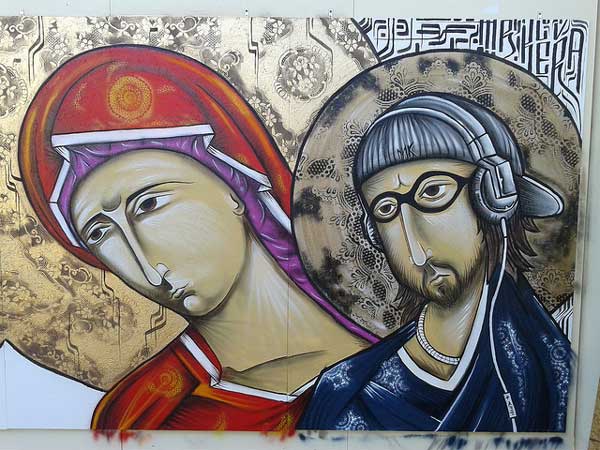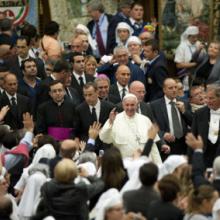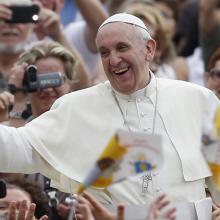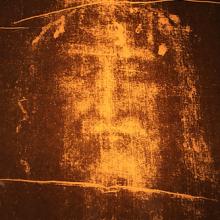Italy
Italian officials on Tuesday moved to expel a Moroccan imam who was caught on video inciting violence against Jews during Israel’s military offensive in Gaza.
Interior Minister Angelino Alfano said he had ordered the imam, Raoudi Aldelbar, to be expelled “for seriously disturbing the peace, endangering national security, and religious discrimination.”
The imam was filmed during a Friday sermon in a mosque near Venice last month calling for Jews to be killed “one by one,” according to the Washington-based Middle East Media Research Institute, which published the video on its website.
“Oh Allah, count them one by one and kill them all,” the imam allegedly preached during the service at the mosque in the northern city of San Dona di Piave.
After the video was aired in Italy by the center-right daily, Libero, Alfano said: “Uttering anti-Semitic sermons that explicitly incite violence and sectarian hatred is unacceptable. May my decision in this case be a warning to all those who think you can preach hatred in Italy.”
The government’s decision drew widespread support across the political spectrum and from the Muslim community in the Veneto region, where the imam is based.
Pope Francis sought forgiveness for decades of persecution of Italian Pentecostals when he met with around 300 evangelicals from the U.S., Argentina, and Italy in the southern town of Caserta on Monday.
The pope made his second visit in as many days to the Mafia stronghold near Naples, this time to meet evangelical pastor Giovanni Traettino, whom he befriended while he was archbishop of Buenos Aires.
During the visit, Francis apologized for the persecution suffered by Pentecostals under Italy’s fascist regime in the 1920s and 1930s and urged Christians to celebrate their diversity and unity.
“Catholics were among those who persecuted and denounced the Pentecostals, almost as if they were crazy,” Francis said.
“I am the shepherd of the Catholics and I ask you to forgive my Catholic brothers and sisters who did not understand and were tempted by the devil.”
Since his election last year, the pope has been reaching out to other faiths and has held talks with Protestant, Jewish, and Muslim leaders. On Monday, he went even further by apologizing for what Catholics had done.
It began with the murder of an innocent 3-year-old boy who burned to death in his grandfather’s car in a Mafia ambush in January. Pope Francis was so shaken by the death of Nicola “Coco” Campolongo that he spoke out against the ferocity of the crime and those behind it.
“They are not with God,” Francis said during his visit to the nearby town of Sibari in the region of Calabria where the global crime syndicate ‘Ndrangheta is based. “They are excommunicated!”
Il Mio Papa, a new weekly magazine that will focus entirely on Pope Francis — complete with a weekly centerfold poster of the pontiff — is scheduled to hit Italian newsstands on Wednesday.
The magazine, whose name translates to “My Pope,” will go heavy on photography and colorful layouts, according to a news release from publisher Mondadori. It’s the first magazine entirely devoted to just one pontiff.
The magazine will include stories about people and events that inspire the pope; background information on papal remarks; a “saints of the week” column; a collection of international cartoons about the pope; and a list of that week’s television programs dedicated to issues related to faith and Christianity.
When Pope Francis cradled the small box said to contain nine bone fragments believed to be the mortal remains of St. Peter, the first pope, he fanned the flames of a long-standing debate over the authenticity of ancient church relics.
Most old churches in Italy contain some ancient relic, ranging from a glass tube said to hold the blood of St. Gennaro in Naples to a section of what is believed to be Jesus’ umbilical cord in the Basilica of St. John of Lateran in Rome. Perhaps the most famous religious relic in Italy — the Shroud of Turin, believed by many to be Jesus’ burial cloth — will go on display again in early 2015, and Turin Archbishop Cesare Nosiglia this week invited Pope Francis to attend its public debut.
But St. Peter’s bones are of particular importance, since they are the very basis — both architecturally and spiritually — for Catholicism’s most important church. And yet the bones were only discovered during a series of excavations in the 1940s, almost 1,900 years after Peter died, in either 64 or 67 A.D.
First, the name “Francesco” leapfrogged to No. 1 on the list of the most popular baby names in Italy.
Then, the city of Rome reported a tourism boom, mostly from Latin America.
Now, there’s word Roman Catholic Church attendance is climbing throughout Italy.
Blame it on “the Francis effect.”
Italy’s Center for Studies on New Religions reported Sunday that around half of the 250 priests it surveyed reported a significant rise in church attendance since Cardinal Jorge Mario Bergoglio became Pope Francis in March.
Moved by the election of Pope Francis seven months ago, the name “Francesco” has leapfrogged to No. 1 on the list of the most popular baby names in Italy, according to a study.
The study, conducted by Enzo Caffarelli, who researches the origins of names at Rome’s Tor Vergata University, along with telephone directory publisher Seat PG Italia, also showed a trend toward re-naming streets, town squares, and parks for St. Francis of Assisi, the pontiff’s namesake.
New scientific tests on the Shroud of Turin, which went on display Saturday in a special TV appearance introduced by the pope, date the cloth to ancient times, challenging earlier experiments that dated it only to the Middle Ages.
Pope Francis sent a special video message to the televised event in the Cathedral of Saint John the Baptist in Turin, Italy, which coincided with Holy Saturday, when Catholics mark the period between Christ’s crucifixion on Good Friday and his resurrection on Easter Sunday.
The Vatican, tiptoeing carefully, has never claimed that the 14-foot linen cloth was used to cover Christ after he was taken from the cross 2,000 years ago, as some believers claim.
VATICAN CITY — Exactly 500 years ago, on Oct. 31, 1512, Pope Julius II led an evening prayer service to inaugurate the Sistine Chapel and Michelangelo's newly-finished vault frescoes.
But as Pope Benedict XVI on Wednesday celebrated the 500th anniversary of the Renaissance masterpiece, the Vatican said the growing number of tourists who visit the historic site every year might eventually lead to limiting access to the chapel to help preserve the frescoes from human-born problems and pollutants.
“We could limit access, introducing a maximum number of entries,” wrote Antonio Paolucci, the director of the Vatican Museums, in L'Osservatore Romano, the Vatican's semi-official newspaper. “We will do this, if the pressure from tourism were to increase beyond a reasonable level and if we were to fail in resolving the problem efficiently.”
Paolucci stressed, however, that in his opinion such measures will not be necessary “in the short to medium term.”
ASSISI, Italy — Swimming against a global tide of religious violence and political polarization, about 550 religious and humanitarian leaders met recently here in the birthplace of St. Francis to propose a new way forward: love and forgiveness.
The ambitious aim of the Sept. 19-23 “Global Gathering” was nothing short of putting those values to work in some of the most hate-filled and unforgiving places on Earth. Following the example of Francis, whose feast day is on Thursday, participants pledged to make lofty ideals real through dozens of creative projects researched and funded by the Michigan-based Fetzer Institute, the conference convener.
“There’s a power in love that our world has not discovered yet,” said Fetzer President and CEO Larry Sullivan, quoting the Rev. Martin Luther King, Jr. “Let’s put our backs into the work of love and forgiveness.”
 ROME — Even in the heartland of global Catholicism, a life-size Madonna on a street wall is an uncommon sight — especially if you leave the cobblestone alleyways of the historic center for the drab concrete of the city's former industrial districts.
ROME — Even in the heartland of global Catholicism, a life-size Madonna on a street wall is an uncommon sight — especially if you leave the cobblestone alleyways of the historic center for the drab concrete of the city's former industrial districts.
But bringing sacred art back to Rome's run-down streets is exactly what a street artist known as Mr. Klevra has set out to do.
Mr. Klevra, a 34-year old Italian artist and a committed Catholic, paints Madonnas and other saints on thin paper posters and then glues them onto walls under the cover of darkness.
"I love the adrenaline of putting up the paintings while hiding from the police," he said. "I love the randomness of having your art torn down after five minutes or see it stay in its place for years and years.''
Mr. Klevra is his artist's name — like many street artists, he doesn't give out his real name, and prefers to keep his identity secret, even shielding his face from cameras.
In his paintings, he combines the millennia-old techniques of Eastern Orthodox iconography with modern tools such as spray paint and Uni Posca pens. Pop culture references sometimes find their way into his work, such as a Madonna with the motto "Only after disaster can we be resurrected,'' a line from American author Chuck Palahniuk's novel, Fight Club.




![St. Peter in Prison (The Apostle Peter Kneeling). Photo courtesy Rembrandt [Public domain], via Wikimedia Commons/RNS](https://sojo.net/sites/default/files/styles/medium_square/public/blog/Rembrandt_st._peter_in_prision.jpg?itok=xFAbgqBx)




